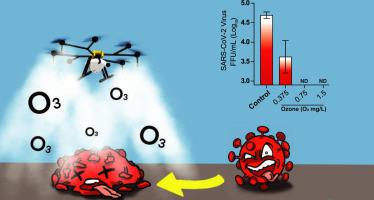Environmental Research ( IF 7.7 ) Pub Date : 2021-02-26 , DOI: 10.1016/j.envres.2021.110944 Simon Albert 1 , Alberto A Amarilla 2 , Ben Trollope 3 , Julian D J Sng 2 , Yin Xiang Setoh 2 , Nathaniel Deering 1 , Naphak Modhiran 2 , Sung-Hsia Weng 4 , Maria C Melo 4 , Nicholas Hutley 1 , Avik Nandy 5 , Michael J Furlong 4 , Paul R Young 2 , Daniel Watterson 2 , Alistair R Grinham 1 , Alexander A Khromykh 2

|
The COVID-19 pandemic has revealed gaps in our understanding of safe, effective and efficient means of disinfecting high use public spaces. Whilst this creates an opportunity for development and application of innovative approaches such as unmanned aerial vehicle (UAV) based disinfection, unregulated outdoor disinfection using chlorine has led to environmental and public health risks. This study has quantified the efficiency, safety and efficacy of UAV-based spraying of aqueous ozone. Optimised UAV flight characteristics of 4.7 km/h at 1.7 m elevation spraying 2.4 L/min were able to provide >97% and >92% coverage of a 1 m and 2 m wide swath respectively. During spraying operations using 1 mg/L aqueous ozone, atmospheric concentrations of ozone remained within background levels (<0.04 ppm). Highly efficient inactivation of two different isolates of SARS-CoV-2 virus was achieved at aqueous ozone concentrations of 0.75 mg/L after an incubation period of only 5 min, with 0.375 mg/L achieving 82–91.5% inactivation in this time. Exposure of diamondback moth larvae and parasitic wasps to 1 mg/L aqueous ozone did not significantly affect their survivorship. These results indicate for the first time that aqueous ozone may provide the required balance between human and environmental safety and viral inactivation efficacy for targeted application in high risk outdoor settings.
中文翻译:

评估无人机喷洒臭氧水作为 SARS-CoV-2 室外消毒剂的潜力
COVID-19 大流行暴露了我们对安全、有效和高效的高使用公共空间消毒方法的理解上的差距。虽然这为开发和应用创新方法(例如基于无人机(UAV)的消毒)创造了机会,但不受监管的使用氯的户外消毒导致了环境和公共卫生风险。这项研究量化了基于无人机的臭氧水喷雾的效率、安全性和功效。优化后的无人机飞行特性为 4.7 km/h,在 1.7 m 高度喷洒 2.4 L/min,能够分别提供 >97% 和 >92% 的 1 m 和 2 m 宽喷幅覆盖率。在使用 1 mg/L 臭氧水进行喷雾操作期间,大气中臭氧浓度保持在背景水平 (<0.04 ppm) 内。仅需 5 分钟的潜伏期后,臭氧水溶液浓度为 0.75 mg/L 即可高效灭活 SARS-CoV-2 病毒的两种不同分离株,其中 0.375 mg/L 在此时间内实现 82-91.5% 的灭活。小菜蛾幼虫和寄生蜂暴露于 1 mg/L 臭氧水溶液中并没有显着影响它们的存活率。这些结果首次表明,臭氧水可以在人类和环境安全与病毒灭活功效之间提供所需的平衡,以便在高风险户外环境中进行有针对性的应用。











































 京公网安备 11010802027423号
京公网安备 11010802027423号